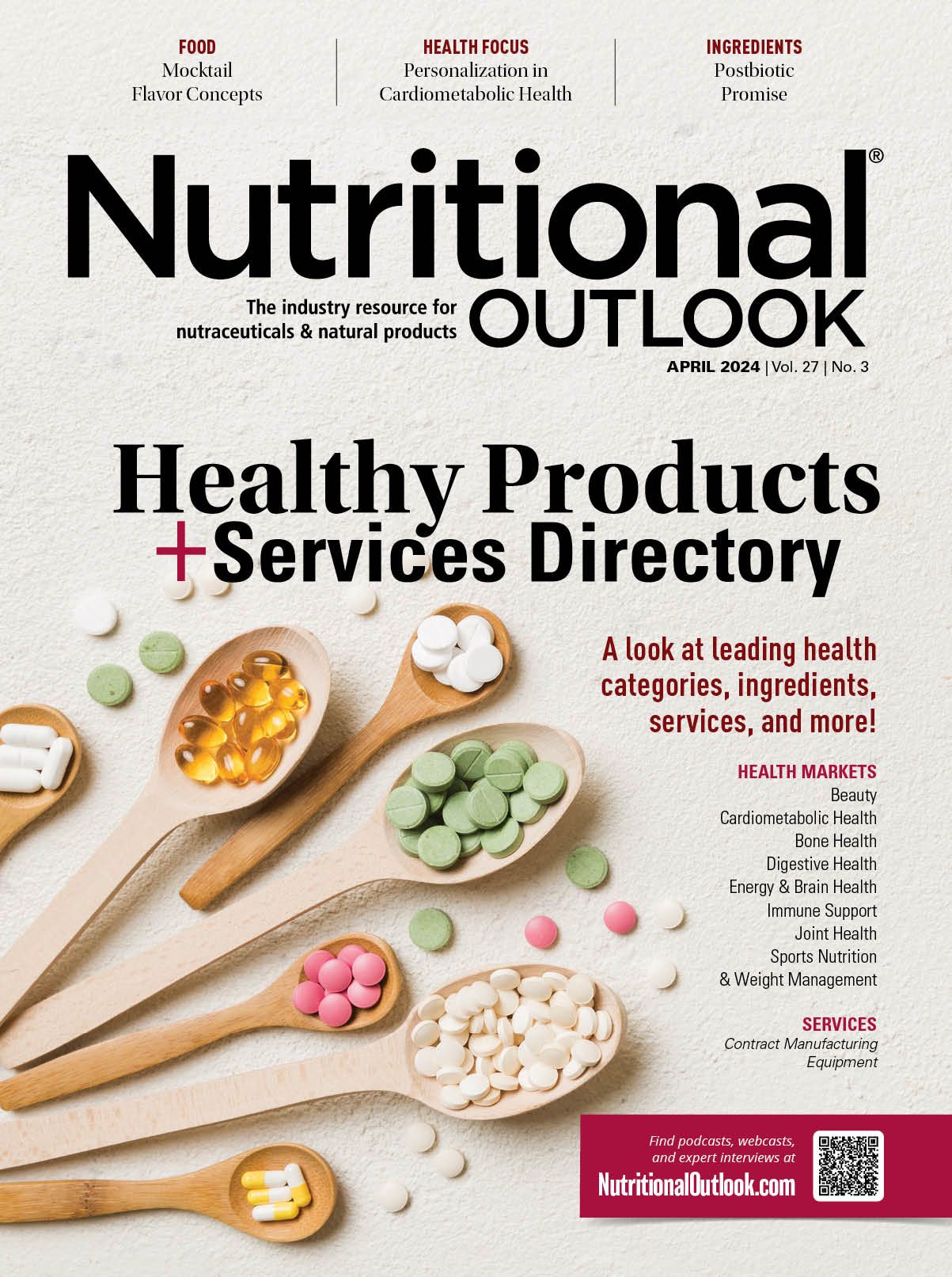The future of cardiometabolic health is personalization
At-home testing and wearable tech will put supplements to the test as consumers measure and track their cardiovascular, liver, and blood sugar health.
Photo © stock.adobe.com/ArtemisDiana

As we enter an age of personalized nutrition, consumers will have access to more resources that help them identify which products work and which products don’t. For those that make the effort to see a healthcare practitioner on a regular basis, cardiovascular health is consistently examined, and when medication is necessary, blood tests and other tools verify whether the medication is having an effect. At home tests, such as the Omega-3 Index Test from OmegaQuant, may offer similar verification. The Omega-3 Index is the measure of omega-3 EPA and DHA levels in red blood cells, and its inventors have published ample research demonstrating how one’s Omega-3 Index may influence the trajectory of one’s long-term health. More than that, it provides a tool for consumers to measure and track the progress of an intervention, specifically omega-3 supplementation, and determine whether the amount of omega-3 fatty acids in their system in increasing.
In one recent study1, for example, 358 patients who had experienced acute myocardial infarction received either 4 grams daily of omega-3 fatty acids or placebo for six months. After six years of follow-up, results did not show a significant reduction in major adverse cardiovascular events (MACE) in the omega-3 group, but the researchers did observe that participants within that group that experienced an increase in their omega-3 index greater than or equal to 5% after six months of treatment did have lower annualized MACE rates. This could therefore indicate the importance of effectively raising red blood cell omega-3 levels. Whether red blood cell omega-3 levels go up from supplementation and diet could be influenced by a number of factors, such as compliance and when the supplement is consumed (such as before a meal). In the real world, the variety of omega-3 products on the market and the potential variability in their EPA and DHA doses may also play a factor.
“Omega-3 supplements come in many different forms, sources, and doses and individuals will also respond differently to the same product and by using tests such as the Omega-3 Index, an individual can assess what product does or maybe does not work for them,” says Jason Polreis, OmegaQuant’s CEO. “Using both of these together can help an individual personalize their nutrition for specific nutrients and vitamins.”
The optimal range of the Omega-3 Index is between 8 and 12%, so the test also allows consumers to set goals and measure progress. This could help improve compliance. “Seeing improvements in their numbers is what motivates [consumers] to keep going,” says Polreis. Lack of progress also helps them determine when they may need to change tact, by increasing how much they take or switching products, for example. OmegaQuant sells their test kit along with fish oil supplements under its sister brand Parasol as a convenience for its customers. While the brand did not feel the industry needed another omega-3 supplement, OmegaQuant did see that there was some confusion in the marketplace. Additionally, the supplements in combination with the tests help the brand further its knowledge, says Polreis.
“We historically have provided education to consumers on how to choose their own omega-3 supplement and there are numerous great omega-3 supplements on the market.We found that part of the problem was just too many choices and consumers did nothing – and kept coming back to us asking for more direction,” he explains. “One of the main reasons we began selling omega-3 supplements through Parasol was to use our founder’s (i.e., Dr. Bill Harris) published research to create personalized nutrition omega-3 programs and take our learnings from this to better support our brand partners’ journey into personalized nutrition.”
Unfortunately, official guidance on how much omega-3 EPA and DHA to consume does not really exist. ALA is the only essential fatty acid that has a set “adequate intake level” while no levels are set for EPA and DHA by the Food and Nutrition Board of the Institute of Medicine (IOM) (now called the National Academy of Medicine).2 This is based on a review of omega-3s conducted in 2005. The American Heart Association (AHA) recommends one to two servings of seafood per week to reduce the risk of cardiovascular disease, stroke, and death, and 1 g/day EPA and DHA for people with existing coronary heart disease, preferably from oily fish, although AHA says supplements may be considered under the direction of a physician. For those that are not at risk for cardiovascular disease, AHA does not recommend omega-3 supplements at all.2
At the same time, omega-3s as a category have been plagued with negative headlines about the ineffectiveness of omega-3 supplements that the industry has frequently described as flawed and biased.3 Therefore, while there are educated consumers, many are ultimately making their decision based on the marketing on a product’s label. Clear and responsible labeling about the product and its benefits is crucial. Structure/function claims that describe the ingredient’s intended affect on the normal structure or function of the human body4 and qualified health claims that describe the relationship between a nutrient and disease risk are two ways to communicate the benefits a dietary supplement. Qualified health claims have more requirements. Omega-3s for example, can carry qualified health claims if they contain a minimum of 800 mg of EPA and DHA combined.5 These include claims about lowering blood pressure and reducing the risk of coronary heart disease or hypertension. However, qualified health claims must also include the statement: “FDA has concluded that the evidence is inconsistent and inconclusive.” This may turn some manufacturers off from that option.
That is not to say that everyone needs over 800 mg of EPA and DHA. The range of doses on the market does not necessarily have to be negative. If a person consistently eats seafood or other sources of omega-3s for example, they may not need such high doses. Offering a range of doses may help retain customers if they start low and decide to increase their intake or vice versa. By being more proactive and taking a greater interest in their health, consumers may also be more motivated to consult physicians about their diet and the supplements they take. This may be beneficial to help lend greater credibility to the dietary supplement industry, so that these products are taken more seriously by healthcare practitioners.
“We work with a variety of healthcare practitioners — RDs, chiropractors, OB/GYNs, midwives, cardiologists, etc — who can both implement testing in their office as well as recommend and refer individuals to get their Omega-3 Index tested,” says Polreis. “There is skepticism about supplements among healthcare practitioners, but by using testing such as the Omega-3 Index practitioners can tailor diet and supplementation recommendations based on their patients’/clients’ actual needs. By retesting, the practitioner can then see the effectiveness of supplementation and adjust dosage and/or products as needed. In other words, using biomarkers like the Omega-3 Index allows practitioners to treat instead of guess when it comes to their patients’/clients’ nutrition and supplementation needs.”
Certain groups, such as expecting mothers would benefit greatly from testing and supplementation to support their health and that of their fetus. “We do see an increase in expecting mothers taking greater care of their prenatal health,” says Polreis. “When it comes to omega-3s, primarily DHA, more women need to be taking this important nutrient. Furthermore, healthcare systems and insurance companies should be looking at DHA testing and supplementation to improve pregnancy outcomes – especially reducing the risk of preterm birth.”
Bigger picture
Like everything else, health is a spectrum, and heart health is one component of a larger, complex system. As such, there is also a growing interest in cardiometabolic health, which encompasses heart, liver, and blood sugar health. Here too, consumers can implement at-home testing to determine their status. For example, a different at-home test called CardioMetaboliQ measures 16 advanced cardiovascular, hepatic (liver), and metabolic biomarkers like inflammation, fatty liver index, anthropometric insulin resistance, hemoglobin A1C, visceral fat, fasting glucose, liver function, and oxidative stress.6 Nils Hoem, chief scientist for Aker BioMarine (Oslo, Norway), recently told Nutritional Outlook about the connection between heart and liver health, the main factor being lipids.7
“It’s the liver that is taking care of the packaging of the lipid particles,” says Hoem. “The liver is also particular in that it stores fat in its own cells in what are called hepatocytes. Every other storage of fat happens within specialized cells called adipocytes, so the liver is really a factory where lipids are taken care of and where the lipids that it sends out to the rest of the body are taken care of and [ensures] the lipid particles have the right composition.”
The buildup of too much fat in the liver is called non-alcoholic fatty liver disease, and it can increase one’s risk of developing metabolic syndrome, which is a cluster of conditions such as high blood pressure, high blood sugar, excess body fat, and high cholesterol or triglyceride levels. That in turn increases one’s risk of heart disease, stroke, and type 2 diabetes. Choline, or sources of choline like krill, which contain phosphatidylcholine, is a nutrient that can support a healthy liver because it has an impact on how lipids are stored in adipocytes. Phosphatidylcholine, for example, carries fat away from the liver.8
According to Sabinsa’s vice president sales & marketing, North America, Ahmed Khan, metabolic and liver health are among the top health categories that will experience significant growth. “We think that metabolic health and liver health as well as brain health will be the three main categories that will be exploding in next three to five years,” says Khan. Sabinsa for its part offers a proprietary herbal blend designed to support liver health, called LivLonga, which is a blend of 20% garcinol from Garcinia indica, 95% curcuminoids from Curcuma longa, and 95% piperine from Piper nigrum. A recent study found that supplementation with the herbal blend (450 mg twice daily) resulted in significant improvements in liver transaminases, liver stiffness, and inflammatory markers, compared to placebo.9
When it comes to blood sugar,personalization may see some major progress in the near future as FDA has just approved an over-the-counter blood glucose monitor (CGM).10
This will provide users real-time feedback about how their diet and exercise are impacting their blood sugar. Here too is an opportunity for consumers to determine the value of dietary supplements in supporting blood sugar. The use of CGMs by non-diabetics has been growing in popularity among athletes and biohackers, and the access to over-the-counter options will only increase their usage as people attempt to learn more about their bodies and optimize their health.
Non-diabetics can use the metrics provided by CGMs to understand how foods with different glycemic loads and physical activity affect glucose responses to improve nutritional and physical activity behavior. Athletes can also use information about glucose values and dynamics to optimize nutritional strategies pre-, during, and post-exercise to improve physical performance and regeneration.11
In this situation, dietary supplements will also be profoundly tested as consumers utilize this technology to figure out what works for them and what doesn’t. Concerns about blood sugar can be deeply felt, like to those of heart health, with people experiencing friends and family struggling or even dying as a consequence of poor heart and blood sugar health. That is why interest in this space from a consumer perspective as well as business perspective remains high. The convergence of these concerns in the form of cardiometabolic health will encourage innovation as consumers are beginning to see how health is interconnected and demand products that offer multiple benefits, which are both convenient and more cost-effective for consumers.
References
- Bernhard, B.; Heydari, B.; Adbullah, S.; Francis, S.A.; Lumish, H.; Wang, W.; Jerosch-Herold, M.; Harris, W.S.; Kwong, R.Y. Effect of six month’s treatment with omega-3 acid ethyl esters on long-term outcomes after acute myocardial infarction: The OMEGA-REMODEL randomized clinical trial. International Journal of Cardiology. 2024, 399. DOI: 10.1016/j.ijcard.2023.131698
- Omega-3 Fatty Acids. National Institutes of Health Office of Dietary Supplements. February 15, 2023. https://ods.od.nih.gov/factsheets/Omega3FattyAcids-HealthProfessional/ (accessed 2024-03-22).
- Harris, B. Omega-3 Cochrane meta-analysis is highly flawed, researcher writes. Nutritional Outlook. August 30, 2018. https://www.nutritionaloutlook.com/view/omega-3-cochrane-meta-analysis-highly-flawed-researcher-writes (accessed 2024-03-22).
- Structure/Function Claims. U.S. Food and Drug Administration. March 7, 2022. https://www.fda.gov/food/food-labeling-nutrition/structurefunction-claims (accessed 2024-03-22).
- FDA Announces New Qualified Health Claims for EPA and DHA Omega-3 Consumption and the Risk of Hypertension and Coronary Heart Disease. U.S. Food and Drug Administration. June 19, 2019. https://www.fda.gov/food/cfsan-constituent-updates/fda-announces-new-qualified-health-claims-epa-and-dha-omega-3-consumption-and-risk-hypertension-and (accessed 2024-03-22).
- Grebow, J. At-home cardiometabolic test launches from CardioMetaboliQ. Nutritional Outlook. August 22, 2023. https://www.nutritionaloutlook.com/view/at-home-cardiometabolic-test-launches-from-cardiometaboliq (accessed 2024-03-22).
- Krawiec, S. The connection between liver and heart health, and the importance of phospholipids: 2023 SupplySide West report. Nutritional Outlook. November 15, 2023. https://www.nutritionaloutlook.com/view/the-connection-between-liver-and-heart-health-and-the-importance-of-phospholipids-2023-supplyside-west-report (accessed 2024-03-22).
- The Nutrition Source: Choline. Harvard T.H. Chan School of Public Health. March 2023. https://www.hsph.harvard.edu/nutritionsource/choline/#:~:text=There%20is%20a%20link%20between,to%20store%20too%20much%20fat (accessed 2023-11-14).
- Majeed, M.; Nagabhushanam, K.; Noureddin, M.; Paulose, S.; Barik, C.; Saklecha, S.; Mundkur, L. A scientifically validated combination of garcinol, curcuminoids, and piperine for mild to moderate nonalcoholic steatohepatitis patients—results from a randomized, double-blind, placebo-controlled study. Front Nutr, 2023, 10, 1201186. DOI:10.3389/fnut.2023.1201186
- FDA Clears First Over-the-Counter Continuous Glucose Monitor. U.S. Food and Drug Administration. March 5, 2024. https://www.fda.gov/news-events/press-announcements/fda-clears-first-over-counter-continuous-glucose-monitor (accessed 2024-03-22).
- Holzer, R.; Bloch, W.; Brinkmann,C. Continuous glucose monitoring in healthy adults—possible applications in health care, wellness, and sports. Sensors (Basel). 2022, 22 (5), 2030. DOI: 10.3390/s22052030





















